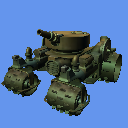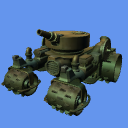

Multisampling is a compromise for people who really want to use supersampling, but can't afford it.
The idea is simple: instead of increasing the resolution for all rendering, what if we do triangle rasterization and depth/stencil tests at the higher resolution, but leave pixel shading and texture lookups at the original, lower resolution?
Where standard rendering goes like:
And supersampling is:
The process for multisampling is:
Unlike supersampling, which can be implemented by drawing to a standard rendertarget and using a pixel shader to apply the final downsize filter, multisampling requires dedicated hardware support. In XNA, it is enabled by adding this to your Game constructor:
graphics.PreferMultiSampling = true;
Because triangle rasterization and depth testing are performed at the higher resolution, multisampling is every bit as good as supersampling at combating triangle edge and geometry aliasing. But because the pixel shader only runs once per final output pixel, it does not help at all with texture map or shader aliasing.
This is an important and easily missed point: multisampling only knows about the edges of polygonal geometry.
Multisampling can smooth the edges of triangles, and also the edges formed where one zbuffered triangle intersects another, but it knows nothing about what happens within the interior of each triangle. Texturing, shading, and lighting produce exactly the same results as if multisampling was not used at all (think about it: the pixel shader runs just once, then we write out 2 or 4 copies of the same color, after which the downsample filter averages these identical colors, producing the exact same value we started with). If your triangles have interior borders caused by texture lookups or shader code (for instance the border of an alpha cutout sprite), multisampling will be irrelevant. This often surprises people when they see aliasing on cutout sprites and turn on multisampling in an attempt to fix it, but nothing changes. Yet this is the nature of the beast. If you want to antialias alpha cutout borders within a triangle, you need supersampling, or one of the texture/shader based techniques I will talk about later.
So why is multisampling popular? (and it is very popular, to the extent where many people confuse the generic term "antialiasing" with the specific technique "multisampling")
Simple: it's cheap. On some hardware (notably Xbox 360) it can be very cheap indeed.
Remember that the GPU is an asynchronous parallel processing pipeline. Multisampling increases the cost of some stages along this pipeline (notably rasterization, depth/stencil testing, and framebuffer writes), but it does not affect the areas that are most often performance bottlenecks (vertex fetch, vertex shading, texture fetch, and pixel shading). Adding work to things that were not the perf bottleneck can sometimes even be entirely free, so multisampling often turns out to improve visual quality for low cost.
Even if you are bottlenecked by framebuffer bandwidth, hardware designers are clever and can pull all sorts of neat silicon tricks to make multisampling efficient, taking advantage of the coherency where the same color value is usually written many times in a row. Why waste memory bandwidth saying "write X, ok, write X again, and again, and one more 'gain", when you could send just a single copy of X over the bus, followed by a couple of bit flags indicating which multisamples this pixel shader result should cover?
Oh yeah, before I go I should show you how it looks. Here's our favorite tank model, first with no antialiasing, then using 4x multisampling:
And the same images zoomed in: